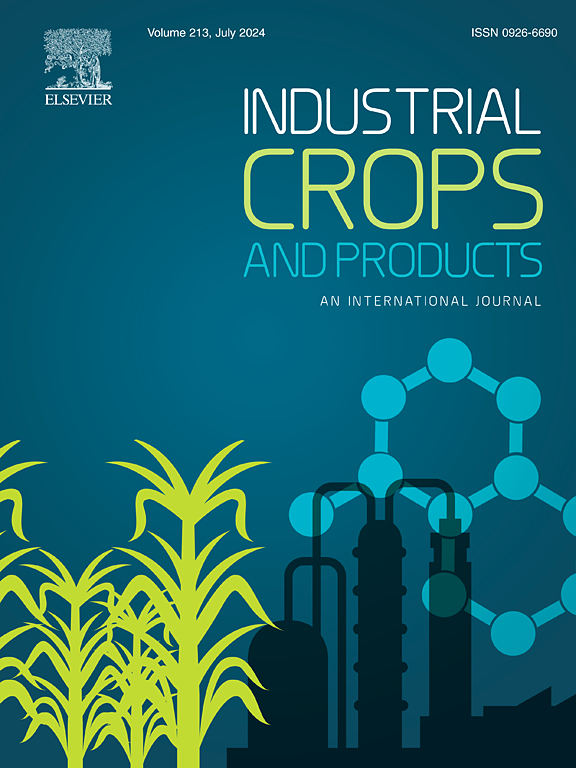大豆(Glycine max (Linn.))生理、转录组和代谢组水平的协同响应在盐碱复合胁迫下
IF 5.6
1区 农林科学
Q1 AGRICULTURAL ENGINEERING
引用次数: 0
摘要
在自然环境中,盐和碱胁迫经常同时发生,这极大地抑制了大豆(Glycine max, Linn.)增长和产量。然而,大豆适应盐碱联合胁迫的调控网络在很大程度上仍然不清楚。本研究旨在通过综合表型、生理学、转录组学和代谢组学分析来阐明这些机制。四个不同耐盐碱大豆品种——禾头一号。在农业研究所的综合评价基础上筛选了黑河6号、黑河35号、中原929号和中原911号。表型和农艺性状在苗期证实了它们的耐受性/敏感性。4个大豆品种在对照、盐、碱和盐碱联合胁迫条件下的生理结果表明,盐碱联合胁迫诱导了独特的生理生化反应,包括活性氧含量增加和光合参数改变。对耐受性品种的代谢组学和转录组学分析表明,与黄酮类化合物、淀粉和蔗糖、α-亚麻酸代谢和氨基酸生物合成相关的关键调控途径参与了这一反应,相关基因和代谢物显著上调。值得注意的是,与对照相比,在联合盐碱胁迫下,l -同型半胱氨酸(C00155)、儿茶素(C06562)和山奈酚(C05903)等关键代谢物上调了2-64倍。此外,与对照组相比,在联合盐碱胁迫下,关键基因如HIDH (K13258)和AAT (K14454)上调了2 - 29倍,表明它们可能是关键调控途径的核心。这些发现有助于进一步了解大豆对多种非生物胁迫的响应,为选育耐盐、碱和盐碱复合胁迫的品种提供理论依据。本文章由计算机程序翻译,如有差异,请以英文原文为准。

Synergistic responses of physiological, transcriptomic, and metabolomic levels in soybean (Glycine max (Linn.) Merr) under combined salt-alkali stress
Salt and alkali stresses frequently co-occur in natural environments, substantially inhibiting soybean (Glycine max (Linn.) Merr) growth and yield. However, the regulatory networks underlying soybean adaptation to combined salt-alkali stress remain largely unclear. This study aimed to elucidate these mechanisms by integrating phenotypic, physiological, transcriptomic, and metabolomic analyses. Four soybean varieties with differing salt and alkali tolerance—Hedou NO. 6, Heihe 35, Zhonghuang 929, and Zhonghuang 911—were screened based on comprehensive evaluations conducted at the Agricultural Research Institute. Phenotypic and agronomic traits confirmed their tolerance/sensibility at the seedling stage. The physiological results of the four soybean varieties under control, salt, alkali, and combined salt-alkali stress conditions indicated that combined salt-alkali stress induced unique physiological and biochemical responses, including increased reactive oxygen species and altered photosynthetic parameters. Targeted metabolomic and transcriptomic analyses of the tolerant varieties revealed that key regulatory pathways related to flavonoids, starch and sucrose, α-linolenic acid metabolism, and amino acid biosynthesis were identified as involved in this response, with significant upregulation of relevant genes and metabolites. Notably, key metabolites such as L-homocysteine (C00155), catechin (C06562) and kaempferol (C05903) were upregulated 2–64 fold under combined salt-alkali stress compared with the control. Additionally, key genes such as HIDH (K13258) and AAT (K14454) were upregulated by 2–29-fold under combined salt-alkali stress compared with the control group, indicating that they may be central to key regulatory pathways. These findings advance the understanding of soybean responses to multiple abiotic stresses and provide a theoretical foundation for breeding varieties with enhanced tolerance to salt, alkali, and combined salt-alkali stress.
求助全文
通过发布文献求助,成功后即可免费获取论文全文。
去求助
来源期刊

Industrial Crops and Products
农林科学-农业工程
CiteScore
9.50
自引率
8.50%
发文量
1518
审稿时长
43 days
期刊介绍:
Industrial Crops and Products is an International Journal publishing academic and industrial research on industrial (defined as non-food/non-feed) crops and products. Papers concern both crop-oriented and bio-based materials from crops-oriented research, and should be of interest to an international audience, hypothesis driven, and where comparisons are made statistics performed.
 求助内容:
求助内容: 应助结果提醒方式:
应助结果提醒方式:


